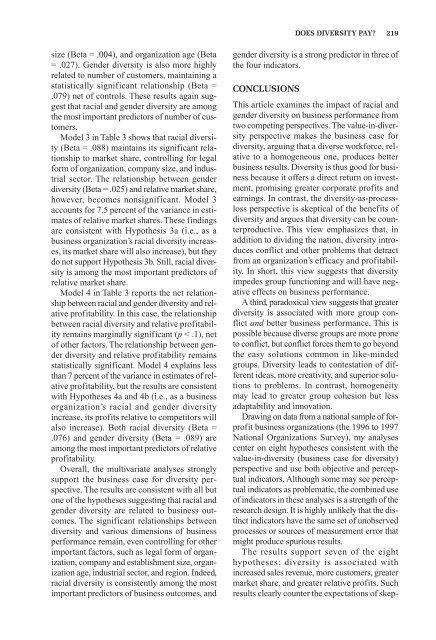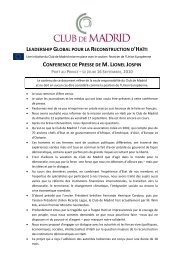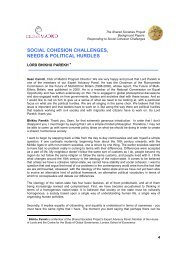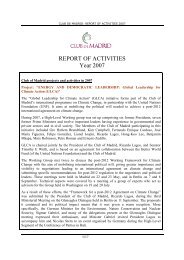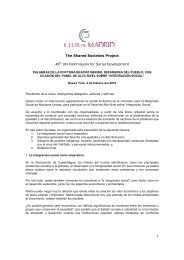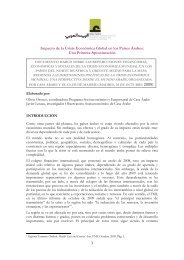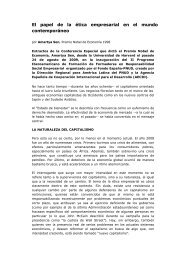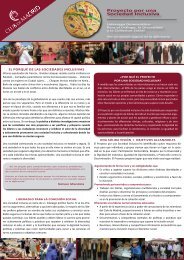Does Diversity Pay? - American Sociological Association
Does Diversity Pay? - American Sociological Association
Does Diversity Pay? - American Sociological Association
You also want an ePaper? Increase the reach of your titles
YUMPU automatically turns print PDFs into web optimized ePapers that Google loves.
DOES DIVERSITY PAY?—–219<br />
size (Beta = .004), and organization age (Beta<br />
= .027). Gender diversity is also more highly<br />
related to number of customers, maintaining a<br />
statistically significant relationship (Beta =<br />
.079) net of controls. These results again suggest<br />
that racial and gender diversity are among<br />
the most important predictors of number of customers.<br />
Model 3 in Table 3 shows that racial diversity<br />
(Beta = .088) maintains its significant relationship<br />
to market share, controlling for legal<br />
form of organization, company size, and industrial<br />
sector. The relationship between gender<br />
diversity (Beta = .025) and relative market share,<br />
however, becomes nonsignificant. Model 3<br />
accounts for 7.5 percent of the variance in estimates<br />
of relative market shares. These findings<br />
are consistent with Hypothesis 3a (i.e., as a<br />
business organization’s racial diversity increases,<br />
its market share will also increase), but they<br />
do not support Hypothesis 3b. Still, racial diversity<br />
is among the most important predictors of<br />
relative market share.<br />
Model 4 in Table 3 reports the net relationship<br />
between racial and gender diversity and relative<br />
profitability. In this case, the relationship<br />
between racial diversity and relative profitability<br />
remains marginally significant (p < .1), net<br />
of other factors. The relationship between gender<br />
diversity and relative profitability remains<br />
statistically significant. Model 4 explains less<br />
than 7 percent of the variance in estimates of relative<br />
profitability, but the results are consistent<br />
with Hypotheses 4a and 4b (i.e., as a business<br />
organization’s racial and gender diversity<br />
increase, its profits relative to competitors will<br />
also increase). Both racial diversity (Beta =<br />
.076) and gender diversity (Beta = .089) are<br />
among the most important predictors of relative<br />
profitability.<br />
Overall, the multivariate analyses strongly<br />
support the business case for diversity perspective.<br />
The results are consistent with all but<br />
one of the hypotheses suggesting that racial and<br />
gender diversity are related to business outcomes.<br />
The significant relationships between<br />
diversity and various dimensions of business<br />
performance remain, even controlling for other<br />
important factors, such as legal form of organization,<br />
company and establishment size, organization<br />
age, industrial sector, and region. Indeed,<br />
racial diversity is consistently among the most<br />
important predictors of business outcomes, and<br />
gender diversity is a strong predictor in three of<br />
the four indicators.<br />
CONCLUSIONS<br />
This article examines the impact of racial and<br />
gender diversity on business performance from<br />
two competing perspectives. The value-in-diversity<br />
perspective makes the business case for<br />
diversity, arguing that a diverse workforce, relative<br />
to a homogeneous one, produces better<br />
business results. <strong>Diversity</strong> is thus good for business<br />
because it offers a direct return on investment,<br />
promising greater corporate profits and<br />
earnings. In contrast, the diversity-as-processloss<br />
perspective is skeptical of the benefits of<br />
diversity and argues that diversity can be counterproductive.<br />
This view emphasizes that, in<br />
addition to dividing the nation, diversity introduces<br />
conflict and other problems that detract<br />
from an organization’s efficacy and profitability.<br />
In short, this view suggests that diversity<br />
impedes group functioning and will have negative<br />
effects on business performance.<br />
A third, paradoxical view suggests that greater<br />
diversity is associated with more group conflict<br />
and better business performance. This is<br />
possible because diverse groups are more prone<br />
to conflict, but conflict forces them to go beyond<br />
the easy solutions common in like-minded<br />
groups. <strong>Diversity</strong> leads to contestation of different<br />
ideas, more creativity, and superior solutions<br />
to problems. In contrast, homogeneity<br />
may lead to greater group cohesion but less<br />
adaptability and innovation.<br />
Drawing on data from a national sample of forprofit<br />
business organizations (the 1996 to 1997<br />
National Organizations Survey), my analyses<br />
center on eight hypotheses consistent with the<br />
value-in-diversity (business case for diversity)<br />
perspective and use both objective and perceptual<br />
indicators. Although some may see perceptual<br />
indicators as problematic, the combined use<br />
of indicators in these analyses is a strength of the<br />
research design. It is highly unlikely that the distinct<br />
indicators have the same set of unobserved<br />
processes or sources of measurement error that<br />
might produce spurious results.<br />
The results support seven of the eight<br />
hypotheses: diversity is associated with<br />
increased sales revenue, more customers, greater<br />
market share, and greater relative profits. Such<br />
results clearly counter the expectations of skep-


